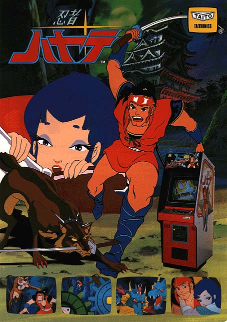Ninja Hayate
 Japanese arcade flyer of Ninja Hayate. | |
| Developer(s) | Taito (arcade version) Telenet Japan, Wolf Team (Mega CD version) Ecseco](Saturn/PS1 versions) |
|---|---|
| Publisher(s) | Taito (arcade version) Wolf Team, Renovation, Sega (Mega CD version) Ecseco (Saturn/PS1 versions) |
| Designer(s) | Toei Animation |
| Platform(s) | Arcade, Sega Mega CD, Sega Saturn, PlayStation |
| Release | Arcade 1984 Sega CD 1993 |
| Genre(s) | Action game, interactive movie |
| Mode(s) | Up to 2 players, alternating turns |
Ninja Hayate (忍者ハヤテ) is a Template:Vgy laserdisc video game first developed and released by Taito exclusively for arcades in Japan. The game became better known when it was released in North America and Europe for the Sega Mega-CD video game console as Revenge of the Ninja in 1993.
Plot
The game tells the story of a skilled and daring teenage ninja named Hayate, whose father has been killed by the evil Lougi, infiltrating the villain's Castle of Evil in an attempt to rescue a princess he loves.[1] Hayate must survive a collection of deathtraps and defeat a variety of mythological creatures and other adversaries on his quest to save the princess and destroy the castle.
Gameplay
The game will draw players to operate Hayate with a joystick for moving him around and one button for using weapons through 15 different stages that take place in feudal Japan-based areas. There are three difficulty levels.
Like earlier laserdisc games such as Don Bluth's Dragon's Lair, Ninja Hayate contains traps and creatures that requires players to dodge or attack them at specific moments, by watching for the warning buzzer (like Dragon's Lair) in addition to flashing objects (e.g. arrows, buttons, light, etc.); if a player makes a mistake, one life decreases, and when players run out of lives, the game ends.
Unlike Don Bluth's laserdisc games, Ninja Hayate is animated with anime drawings by Toei Animation. Another difference is that the game flashes the buttons that need to be pressed directly on the screen. Sometimes it also flashes multiple possible button presses on screen, indicating different paths that the player can take.
The Revenge of the Ninja Sega Mega-CD version was published by Renovation Products, Telenet Japant's North American subsidiary; this is the only version released internationally. The game's battle music was sampled by The Immortals in "Mortal Kombat (Techno Syndrome)", the theme song to the 1995 film adaptation of Mortal Kombat.[2]
This game was also later converted by Ecseco to the Sega Saturn and PlayStation. These versions were released only in Japan as part of a double bill with Time Gal, another animated laserdisc arcade game conversion made by Taito. The double bill was released as Interactive Movie Action - Time Gal and Ninja Hayate.[3]
See also
References
- ^ GamePro 59 (June 1994)
- ^ "Taito". WhoSampled. Retrieved 2 June 2012.
- ^ Interactive Movie Action - Time Gal & Ninja Hayate
External links
- Ninja Hayate at Dragon's Lair Project
- Ninja Hayate at the Killer List of Videogames
- Ninja Hayate at arcade-history
